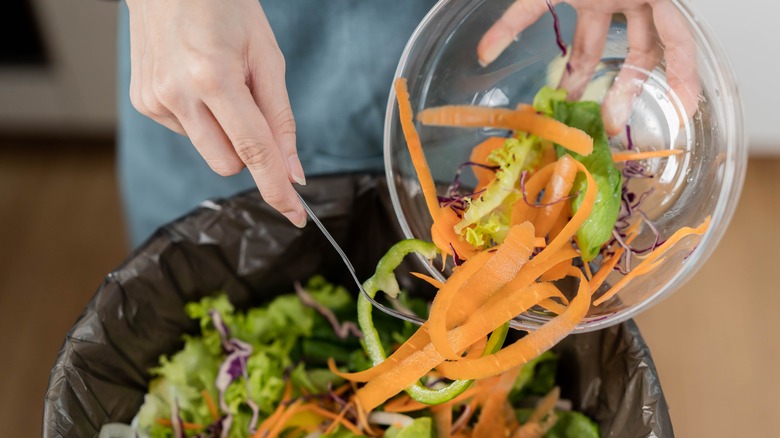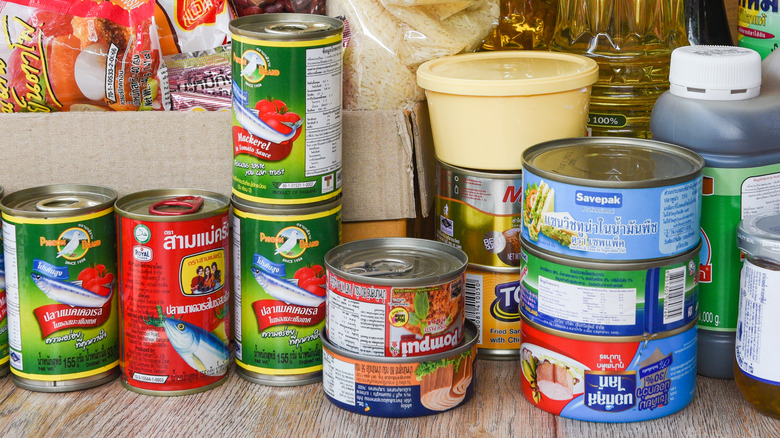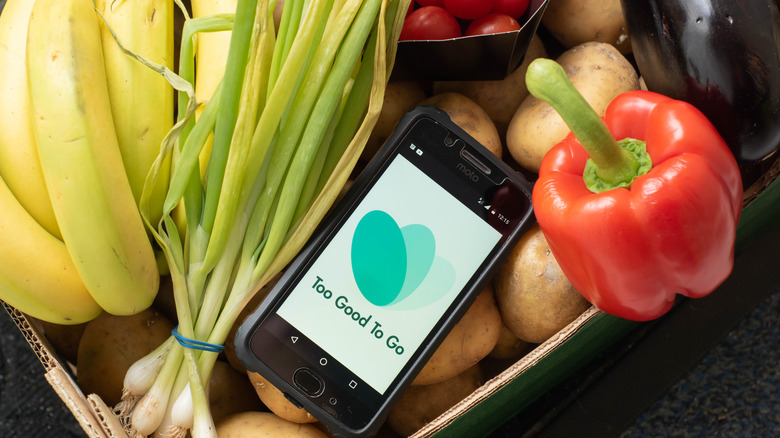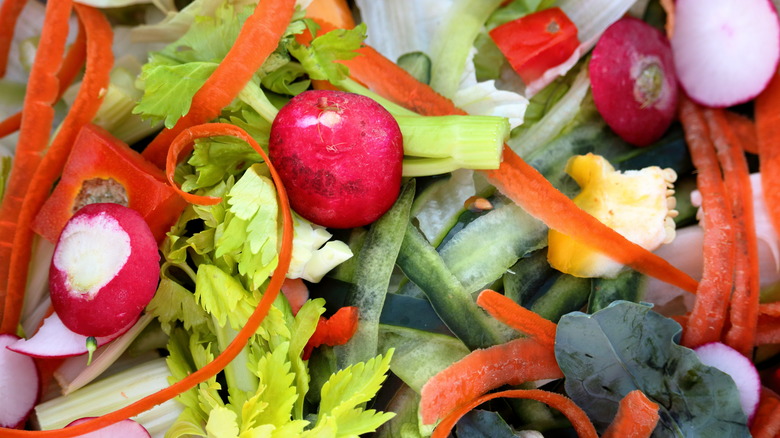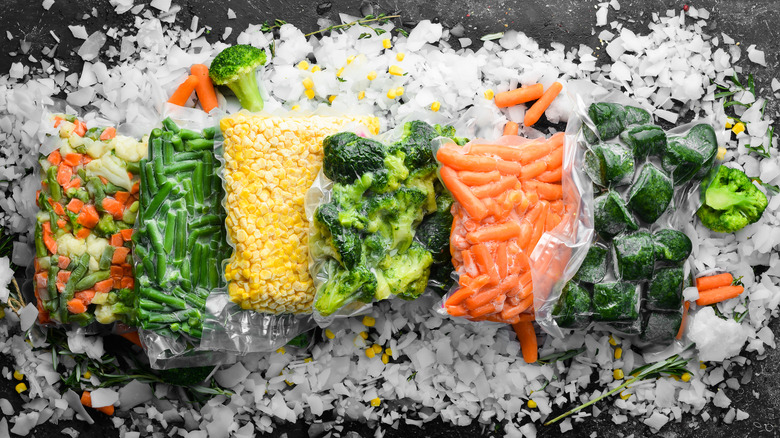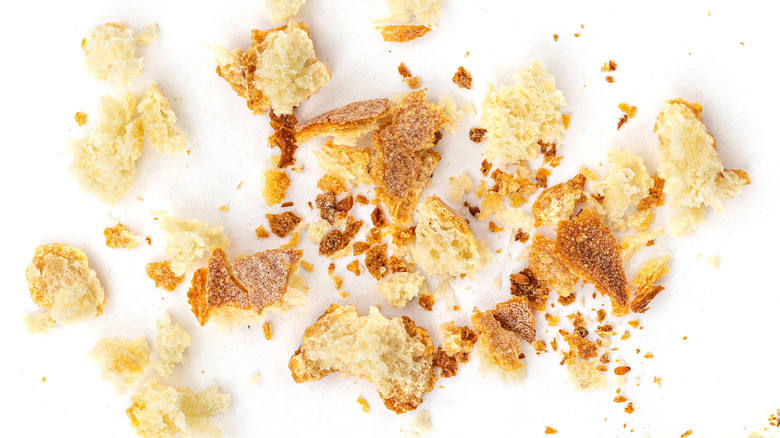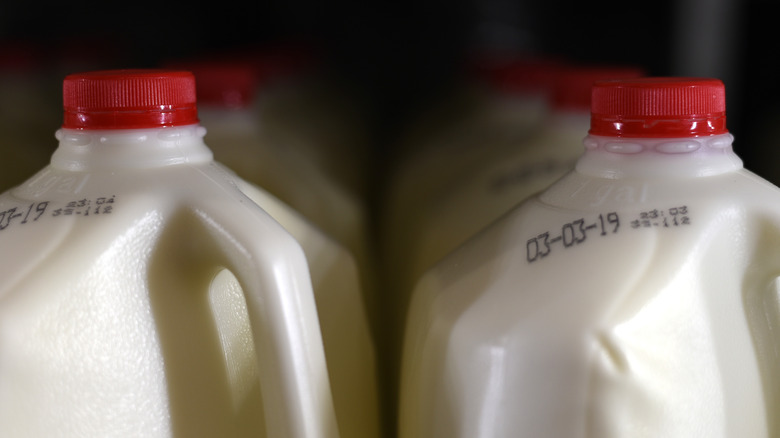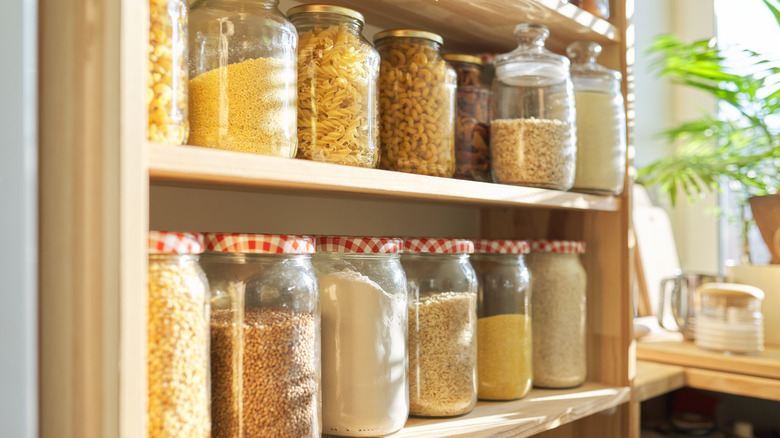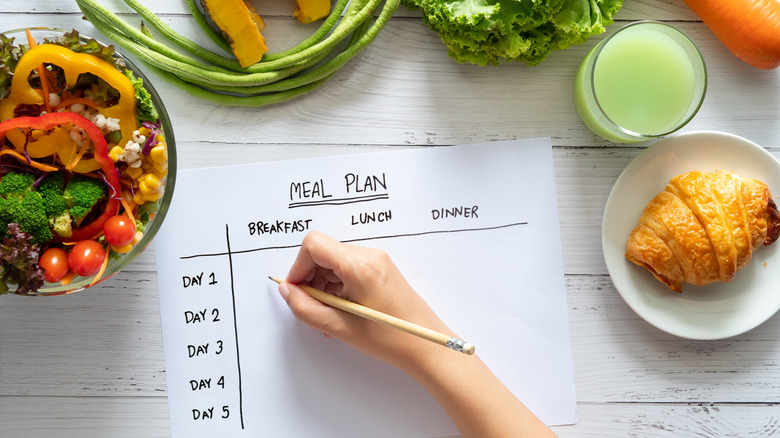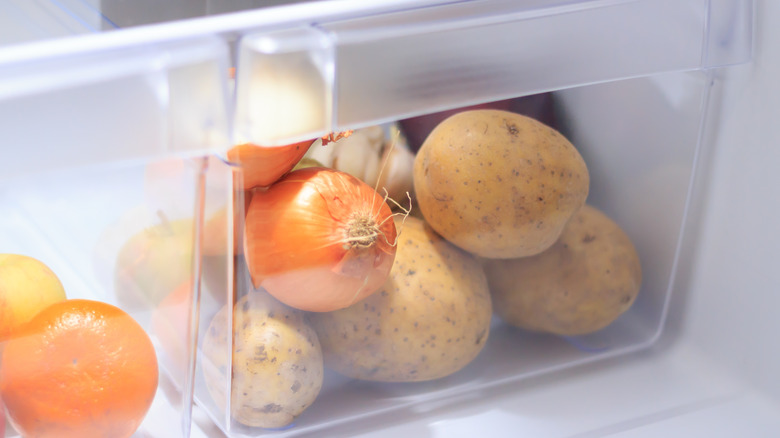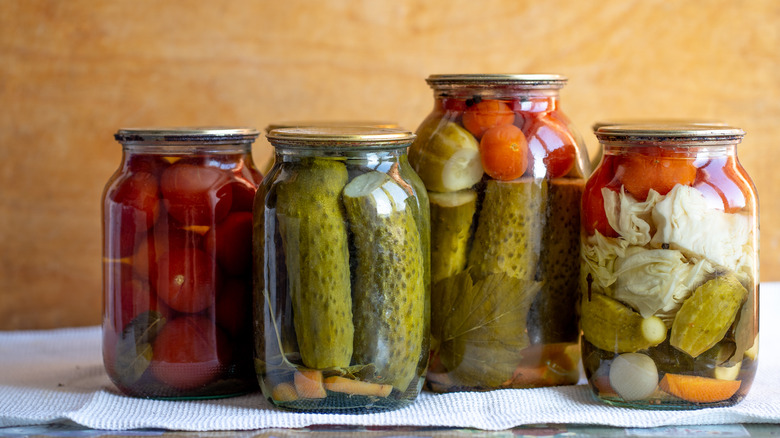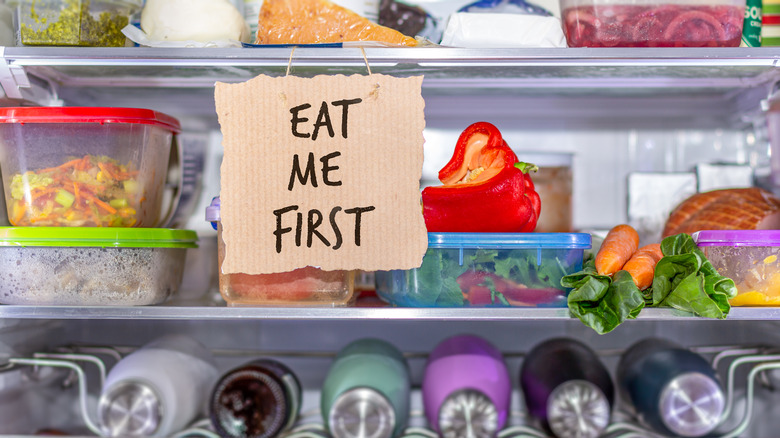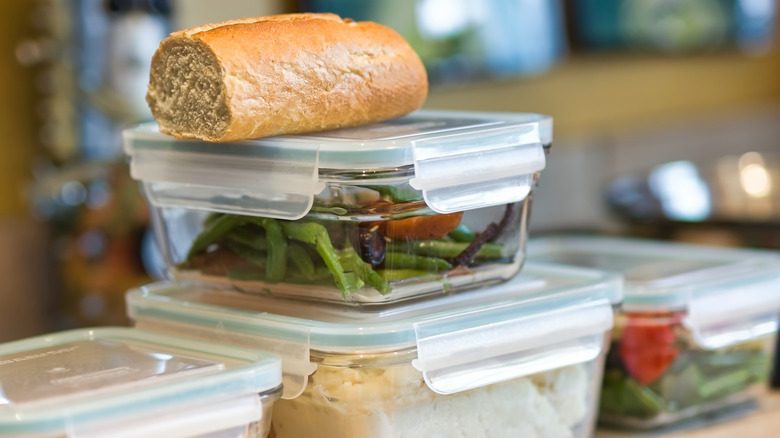12 Tips For Avoiding Food Waste On A College Budget
College: It's one of the most exciting times in your life, but it's probably also one of your brokest. Balancing work and studies can be a challenge, and to make matters worse, you probably don't have a lot of extra time on your hands. When you're trying to make your grocery budget stretch every week, it can be frustrating to find that the food you bought is going bad in the back of your fridge. It feels like you're basically just throwing your money away.
Food waste is a big problem in the U.S. According to the USDA, it's estimated that around 30% to 40% of the food supply is wasted — that's a massive amount of food. So this isn't just a problem for your wallet on an individual level. Rather, it's a society-wide issue. Addressing food waste in your own kitchen can help you save money, but it's also a great step toward making your dinner table a more sustainable place.
So, just how do you reduce food waste at home — and ensure you're not throwing your money down the garbage disposal? Take a look at these simple tips for avoiding food waste on a college budget.
Buy canned and frozen foods
Walking into a grocery store, it's easy to be captivated by all of the fresh produce. The bright colors, the pleasant smells, and the allure of abundance are tempting. Plus, fresh produce just feels healthier than the other options. But as it turns out, if you're trying to cut down on food waste, you may be better off choosing canned or frozen veggies and fruits instead. According to the Washington Post, buying frozen and canned foods generally results in less food waste. And considering that about half of our fresh produce ends up in the trash, this is a smart place to start. You can keep these foods on hand for a longer period of time, leaving them in the pantry or the freezer until you use them. You don't get the same kind of grace from the fresh stuff.
Not only can buying canned and frozen foods help you reduce food waste, but it can also help you save money on your grocery bills. Often, canned and frozen produce is cheaper than the fresh counterparts, which means that you're using two money-saving strategies at once. When your budget is tight, this can make a significant difference at the end of the month.
Use food waste apps
One of the best ways to fight food waste and get cheap or free food at the same time is by utilizing food waste apps. There are a variety of apps out there that can help users locate free or reduced-cost food that's about to go to waste. By matching hungry people with restaurants and grocery stores with extra food, these apps help cut down on food waste while simultaneously getting people the food they want at a reduced cost. The app Too Good to Go shows users where to pick up unwanted food in their local area. Then, users can grab groceries and restaurant meals for a drastically reduced price.
Olio works in a similar way, but neighbors and others in your area can post the unwanted food they have in their kitchens so you can pick up produce or swap something you have that's about to go bad.
Make broth from veggie scraps
When you're trying to prevent food waste in your kitchen, you'll want to get creative. What do you usually throw out that you could instead use and turn into something new? If you cook with fresh veggies, then you know you always have a ton of scraps: The tops of tomatoes, carrot greens, and onion ends often end up in the trash. But did you know that there's actually a use for these seemingly useless extra bits and pieces? One of the simplest ways to use up food that would otherwise go to waste is by making veggie broth from your vegetable scraps.
Blog Maddy's Avenue suggests using all of these extraneous pieces of produce in a veggie stock. When you have vegetable scraps, instead of throwing them away, save them. We like putting them into a gallon plastic bag in the freezer. Then, when the bag is filled and you have some extra time, stick the scraps into a pot with some water and salt, and start simmering. In just a few hours, you'll have savory veggie broth that you can use in a variety of recipes. Use it right away to make a soup or a gravy, or freeze it for later.
Of course, you don't have to stop with veggie scraps. Saving leftover meat, bones, and carcasses is a great way to make your own chicken, beef, pork, or seafood broth at home.
Freeze food that's about to go bad
You probably have every intention of eating all of the fruit and veggies you buy, but sometimes, life gets in the way. It's a bummer when you notice that the fresh berries you just bought are already starting to look funky. If you can't use them in a recipe right away, you may think that all is lost. But, alas, that's not the case. As long as you have room in your freezer, you can make it work. When your food looks like it's starting to go off, just pop it into the freezer, says Honestly Modern. This works especially well with fruit: Freezing it provides you with everything you need to make a smoothie in the future. Simply wash and place berries and cut fruit into a bag in the freezer.
You don't have to stop at fruit, though. If you meant to cook some meat but never got around to it, throw it in the freezer until you're ready to use it. You can do the same for bread that's about to go off. And while you probably don't want to freeze and unthaw fresh veggies to use in salads, frozen vegetables can be used in a variety of cooked dishes.
Find a new use for stale bread
Some breads have a lot of preservatives in them that may not be great for your health, but they do last longer. But when you buy fresh bread, you have to use it in a couple of days before it goes moldy or stale. If you already have a loaf on your counter that's starting to get hard and tasteless, you may think all is lost. However, there's actually a lot you can do with the stale bread you have on hand. Insanely Good Recipes has some easy ideas that will allow you to hold onto that bread for a while longer.
Some of the most popular ways to use up stale bread include making croutons and breadcrumbs. It's quick, it's easy, and pretty much anyone can do it in just a few minutes. If you're looking for something a little more exciting, you may want to try making panzanella, an Italian bread salad recipe, or bread pudding, a delightful and filling dessert that requires stale bread.
Know the difference between 'best by,' 'use by,' and 'sell by' dates
See that little date printed on your packaged food product? It's easy to see that date and assume that, even if only one day has passed, it will cause food poisoning. But often, that's not the case. In fact, you should be paying close attention to what's printed above the date. There's actually a big difference between "best by," "use by," and "sell by" dates, according to the USDA.
When you see "best if used by" or "best before" on a product, it just means that the product will be at peak freshness before the date indicated. You can use a product beyond this date. "Sell by" should be used by grocery store management — it's not even information meant to be used by buyers. "Use by" is usually also indicative of quality, not safety, but it should be taken seriously if it's printed on baby formula. "Freeze by" is exactly what it sounds like — if you haven't yet used the product, it's probably a good idea to throw it in the freezer when you get the chance. It does not mean the product has gone bad.
Knowing the difference between these terms can prevent you from throwing out stuff that's actually still perfectly fine to eat.
Keep stock of what's in your fridge and pantry
Often, food goes to waste not because we don't want to eat the food in question, but simply because we forget that we even have it on hand. It's easy for food to get lost in the pack of the pantry or freezer, and once we find it, it's already gone bad. This is why it's so important to pay attention to what you already have in your kitchen, especially before you go to the store, according to blog Lydia's Flexitarian Kitchen. You don't want to pick up multiples of something you already have, as these extra costs can seriously cut into your grocery budget.
This is also a great way to figure out what other ingredients you should buy when you're at the grocery store. You may get inspired by what you already have in your kitchen, and you can base a meal or two around that. That means you have to buy less when you're at the store, and it also helps you use up the stuff that may not last another week.
Plan your meals in advance
That brings us to our next tip: Plan your meals in advance. We know, we know, not everyone likes meal prepping. But you don't have to be one of those people who freezes an entire week's worth of meals — just knowing what you're going to make before you go shopping can ensure that you don't buy too much when you're at the store. In fact, Stop Food Waste even suggests meal planning as a method for reducing the amount of food that goes in the trash.
Of course, it always helps to have some go-to recipes that you can make using your favorite staple ingredients. If you always have pasta on hand, you may want to plan to make spaghetti with veggies two nights a week. Tend to keep rice in your pantry? Then a canned salmon rice bowl with mayo may be a frequent recipe in your weekly rotation. Planning a week's worth of eating based on what you have in the pantry and pick up at the store can be challenging at first, but once you start planning your meals ahead of time, you'll see that it actually makes your life way easier when your stomach starts grumbling.
Store your produce properly
Some types of produce, like fresh herbs and strawberries, have an especially short shelf life, while others can be left on your kitchen counter or in the fridge for a longer period of time before you'll have to use them (or trash them). Regardless of what kind of produce we're talking, though, it's a good idea to know how to store it properly.
According to Unlock Food, leafy greens should be rinsed, wrapped in a paper towel, and placed in a bag, while root veggies like squash, onions, and potatoes should be stored in a cool, dry place like a cellar or a dark cupboard. Though you may think tomatoes should go in the fridge straight away, you won't want to store them there if they haven't ripened yet. (Once they're ripe, you can place them in the fridge.)
Knowing how to store your produce properly can help it last longer so you have more days to use it up before it goes bad.
Learn how to can
If you're really dedicated to reducing food waste and saving money, then you may want to learn how to can. Of course, this does take quite a bit of time, so it's often not a perfect solution for those who are super busy (which many college students are). But if you have some time off during the summer and you're looking for ways to stretch your food budget for the upcoming year, learning how to can is a fun and practical way to make sure you cut down on food waste.
Per Farmer's Almanac, summer is a great time to can because there will be a ton of seasonal fruits and veggies. You can grow your own, of course, but even buying your veggies in season will help you cut down on costs. Take advantage of cheap and abundant tomatoes, green beans, cucumbers, and zucchini during the summer by canning them so they last you for months to come.
Canning your own foods allows you to customize your produce to your preferences so you don't have to rely on the canned foods you find at grocery stores. Plus, it means that you won't have to trash all those extra fresh tomatoes you found at the farmer's market.
Implement a FIFO system
If you've taken anything from these tips so far, it should be this: Planning ahead of time helps you cut down on food waste and save money. Part of this planning involves knowing what you have in your fridge and when you bought it. According to Michigan State University, this is an important facet of a FIFO system. Never heard of it before? It just means "first in, first out." Whatever you purchased first should be consumed first. For example, you should find a way to use last week's bag of spinach before you break into this week's bag of kale. Doing so ensures that you use up old food as quickly as possible.
For those who easily forget when they bought what (which is probably most of us), labeling your food is a great place to start. You can use bins, stickers, or anything other kind of labeling system that makes it clear to you what you bought when. By making this slight change, you can make your kitchen much more efficient.
Eat your leftovers
This one may sound obvious, but it still deserves to be said, considering that leftovers account for much of the food in our fridges that goes to waste. That's why Choose to Reuse says it's so important to learn how to utilize your leftovers. It goes beyond just heating up the contents of your last takeout box, though. There are plenty of ways to use your leftovers so you're not throwing money away and producing more food waste.
Of course, you can eat your leftovers just as they are by flipping them into lunch the next day. (In fact, cooking an extra serving at night is the perfect way to ensure you don't have to worry about tomorrow's lunch.) But if you're tired of the dish you made, you can always remix it into something new. Did you make boiled potatoes a couple of days ago? Try making a potato salad with the leftovers. If you know you're not going to eat the leftovers in time, freezing them is also a solid option.
However, the best way to use up your leftovers is to make sure that you don't have any in the first place. Find multiple ways to use single ingredients you buy so you don't have to contend with the half of an onion you didn't plan for, and don't cook large batches of food if you know you're not likely to finish them.
